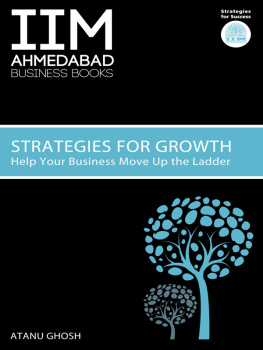Dear Reader,
The book you are holding is one of the books from the IIMA Business Books series published in collaboration with Random House to disseminate knowledge to executives in a manner that brings them up to date in different fields of management. The books are written by authors who have rich experience of teaching executives from a diverse set of organizations. Written in a conversational style with numerous illustrations from the world of experience, you will find the books useful in your work life. The references cited in the books provide you with ready information on where to look for more detailed information on specific topics and concepts. I am certain you will enjoy reading the book. Write to us suggesting topics that you will like being covered in the books that are to be published under the series in the future.
Samir K. Barua
Director
IIM Ahmedabad

INDIAN INSTITUTE OF MANAGEMENT AHMEDABAD
BUSINESS BOOKS
Strategies for Growth
HELP YOUR BUSINESS MOVE UP THE LADDER
ATANU GHOSH

RANDOM HOUSE INDIA
Published by Random House India in 2010
Copyright Atanu Ghosh 2010
Random House Publishers India Private Limited
MindMill Corporate Tower, 2nd Floor, Plot No 24A
Sector 16A, Noida 201301, UP
Random House Group Limited
20 Vauxhall Bridge Road
London SW1V 2SA
United Kingdom
This eBook is copyright material and must not be copied, reproduced,
transferred, distributed, leased, licensed or publicly performed or used
in any way except as specifically permitted in writing by the
publishers, as allowed under the terms and conditions under which it
was purchased or as strictly permitted by applicable copyright law.
Any unauthorised distribution or use of this text may be a direct
infringement of the authors and publishers rights and those
responsible may be liable in law accordingly.
EPUB ISBN 9788184001686
To my wife Oliva,
daughter Anulipi,
and all family members
and
my teachers, friends, colleagues, and well-wishers
all over the world
Acknowledgements
I have been thinking of writing some books in the areas of my interest for the last couple of years. But this dream always had to be pushed aside, because other priorities took precedence.
It was in a very interesting way that I started writing this book on putting together the various ways in which organizations choose to grow and the importance of growth strategies in satisfying most of the stakeholders. It was during a discussion with Professor Samir Barua, the Director of IIMA that I happened to mention to him that another colleague of mine, a former teacher, Professor M.R. Dixit and I had decided to offer a Management Development Programme on Strategies for Growth. He immediately advised me to think about writing a book on this subject. By that time, IIMA had agreed to publish a series of popular management books to be written by faculty members of IIMA. This happened to be one of topics listed by the publisher as a possible topic of interest to professionals.
Incidentally, I have also been teaching a compulsory course, Strategies for Corporate Growth to the participants of Post Graduate Programme in Management for Executives (PGPX), for the last three years. While searching for an ideal textbook on the subject, I couldnt find one. I always, therefore, was looking for an opportune time to pen down my thoughts, accumulated learning, and insights that I had gained from various articles/research papers and cases, so that the gap for such a textbook could be met.
When I was requested by Professor Barua to write this book, I was very reluctant to do so and was doubtful of completing such a demanding task within the stipulated timeline since I had several other prior commitments. But as it is said, much good work comes out of pressure and stress. This book is probably going to be proof of that. This has been also possible due to very strong support I got from two research scholars at the Institute.
Professor Samir Barua continuously encouraged and inspired me to complete this Herculean task. Chiki Sarkar and Priyanka Sarkar from Random House India played the role of alarm clocks to wake me up whenever I missed the deadline, even if by a day. They also accommodated several delays and requests from my end.
The participants of PGPX of the last three batches (2008, and 2009), at IIMA helped me to sharpen my understanding of growth issues and challenges, during the course of my teaching this subject to them.
I am thankful to many authors of the articles that I have referred to in this book. All of them were glad to know about it and conveyed their best wishes. They areProfessor Philip Kotler, Professor Prashant Kale, Professor Don Hambrick, Professor Vijay Govindarajan, Professor Tarun Khanna, Donald L. Laurie, Derek van Bever, Professor Harbir Singh, Professor Clark Gilbert, Professor Shekhar Chaudhuri, Professor Robert James Harrington, and Dr Elaine M. Cummings.
In spite of all the pain I have gone through during the past several months while writing and editing this book, at the end of the journey I feel extremely happy that I was able to finish this demanding task in time, much to my satisfaction.
Introduction
All organizations aim to follow a trajectory of uninterrupted growth, irrespective of their nature. It doesnt matter if an organization is big or small, family or professionally managed, owned by private investors or public, or whether its manufacturing or service based. That said, the ways of attaining growth are not simple. Depending on a variety of factorsfrom the size of the organization, its available resources, current trends in the business environment, the aptitude of its staff or the product or service being soldgrowth can take many forms and be achieved through various means. Certain organizations may be in a position where an initiative such as market penetration is the best option, whereas some larger companies may benefit most by a merger or even the takeover of another company. As you will see, each decision must be taken carefully, after much research and deliberation and based on what makes sense logically.
This book begins with an understanding of the objectives for pursuing growth strategies, contextual differences between different routes with real examples of how companies have been successful in their bids to grow. Also stressed and explained are the challenges various types of organizations must face to maintain their profitability as they grow bigger. All too often organizations rest on their laurels when they reach a certain size, but as things get more complicated, it is all the more important to be vigilant and also stay creativeboth with current products and services as well as in developing new ones.
This book focuses on various strategies that companies can adopt to achieve sustainable and profitable growth. It is important to realize that to do so, it is imperative to understand the organizational or management challenges that may arise in this context. When a certain growth strategy is implemented, a few challenges are thrown up. If the challenges, both faced when the venture is in progress as also those that appear after the strategy has proven to be successful, are not understood then an organization could find itself in big trouble. This may happen even if their initial plans are successful.








